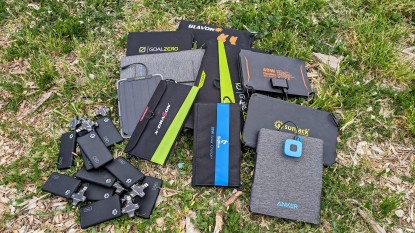The Goal Zero Sherpa 120 portable solar charger is a relatively light and durable portable solar kit that can charge just about anything. If you have a lot of electronic devices to charge and spend a fair bit of time away from a power source, this is the device to get.
That said, it is very expensive. If you just need to charge a cell phone, camera or other small device, we recommend the Goal Zero Nomad 7 which is far less expensive and lighter.Goal Zero Sherpa 120 Kit Review
Our Verdict
Our Analysis and Test Results
Likes
This is the first portable solar panel kit that we feel we can do anything with. We have used it to power our home office, recharge our electric bike and power all our phones and personal electronic devices.
What makes this kit stand out is the ease of charging AC devices. Not other device we have tried is so easy. That said, not all AC devices work. You need to check your power needs on each individual item.
We were able to completely recharge our electric bike in an hour. We were able to run our laptop and 27" LCD monitor for three hours (we have tried and failed many times to get other portable solar options to charge an energy-sucking LCD monitor). You can plug in and recharge a solid portable speaker. The battery is also very durable, it has clip-in points, and has rubber on the bottom to give it good traction (this came in very handy on a sailboat).
The Nomad 27 panel is very powerful for its size and weight. We were impressed with how fast it charged the Sherpa Battery. It has 4 large grommets, the size that will accomodate a carabiner, on each corner. We took advantage of this on a five-day sailing trip and often used the panel as an extra sun shade (see photo above). We also found it worked great with our pedal-assist electric bike. On one weekend we loaded the electric bike down with food and drink supplies and rode it 20 miles to a BBQ over some hilly terrain. We then charged the bike at the BBQ and were able to return by sun power (and leg power).
One of the best things about any Goal Zero panel is all the flexibility it gives you with growing your system. For years it has been easy to find a panel that charges your cell phone but always much harder to find a reliable system to run a base camp, mobile office or RV. With Goal Zero you can start with just a panel then add batteries, lights, inverters and other accessories as needed. No electrical engineering degree required. Everything just works.
Dislikes
The main drawback to this kit is the price: it retails for $830. While you can often find it on sale for $600, that is still a lot of money. So it comes down to how much you need AC power in the field and how much power you need period. For example, if you were doing a trip to an area with horrendous weather with no sun for days, and need to charge a lot of equipment, this kit is perfect. If you just need to charge a few small devices here and there, there are much more cost effective options.
Another dislike is the need to have a Goal Zero battery or a separately sold cigarette adapter for this kit to do anything. The first time we tried to use a Goal Zero Nomad 13 or 27 panel on a climb on El Capitan, we had to leave it behind because someone forgot to pick up the battery kit or adapter. It would be great if Goal Zero designed the Nomad 13 and Nomad 27 panels the way they design the Nomad 7, which allows you to plug one or two devices directly to the panel.
After a year of solid use, the battery indicator became unreliable. It was either full or blinking on empty. We would charge it up to full, leave it around for a few days, check on it and it would say empty even though it had a full charge. It worked fine — the battery indicator just had only two settings: full and less than full (which was indicated as empty).
One minor dislike: at certain times the Sherpa UI inverter fan would power on and off every 30 seconds to a minute. It was annoying but not in a way that drove us crazy.
Unfortunately, the panel won't plug directly into the inverter. So you need to always have the weight and expense of a Goal Zero battery.



